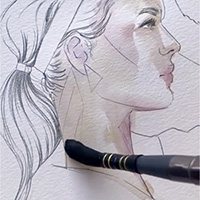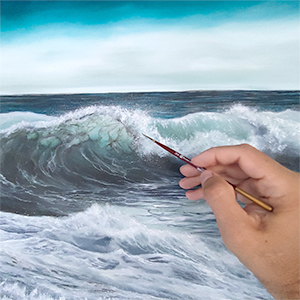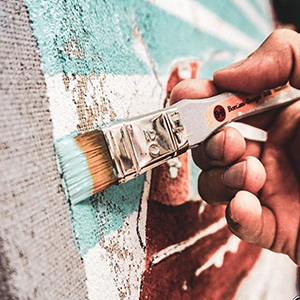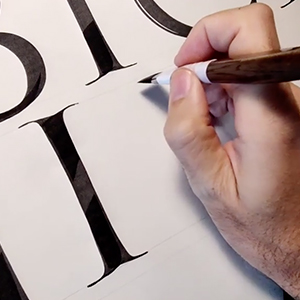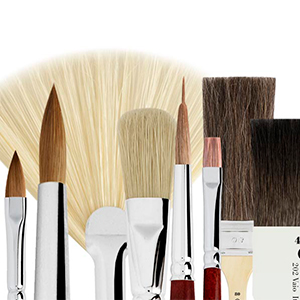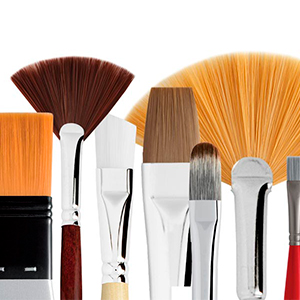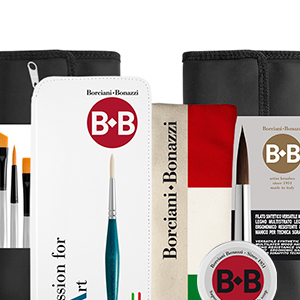Chinese Ink: The Complete Guide
Chinese Ink: The Complete Guide
India ink, also known as Chinese ink or simply China ink, is a black ink used for writing, drawing, and painting.
India ink, also known as Chinese ink or simply China ink, is a black ink used for writing, drawing, and painting: tools dedicated to creating marks and lines that have made communication between humans possible, the transmission of culture between generations, and the dissemination of knowledge worldwide.
Believed to originate from the East, China or India, it combines a black carbon pigment with a water-based binder.
It is indelible and, after drying, has a shiny appearance.
Its composition varies: it can commonly be found in liquid form or in solid sticks, known as Sumi.
The term Indian Ink commonly refers to a vast variety of liquid preparations, particularly used in comics for inking drawings after the pencil sketch phase and sometimes in technical drawing; the solid form is instead used in calligraphy and painting.
The pigment in India ink is lamp black: slightly brownish, which is especially noticeable in strong dilutions, it is often modified with dyes to change its hue and make it more intense.
Indian varieties may contain metallic oxides, those manufactured in Egypt use charcoal, and European productions generally add carbon black pigments.
Although it is a product that is very common today, its history is ancient and fascinating with incredible evolutions.

Composition and Characteristics of India Ink
There is no single "India ink" with a fixed formula, and not all black inks are "India ink," so their composition is almost never indicated on the packaging.
For English-speaking countries, India ink is known as "Indian Ink," while in Dutch it is called "East Indian Ink" (Oost-Indische Inkt).
The exact dates of the appearance of the various types of ink are not well known, but we can admire the wonderful works on parchment from ancient Chinese dynasties, still visible today due to their lightfastness and permanence.
Depending on the form, solid or liquid, the composition can vary, and it certainly has over the centuries.
The Ink Stick, or Solid Sumi Ink
Unlike other inks, traditional India ink was created to be stored in solid form as a small block, which would then be liquefied only when needed.

These sticks were made with various types of soot mixed with glue and were decorated with a variety of phrases and motifs. Some were true miniature works of art, adorned with characters or figures in various colors, including red, a color of good luck in China, as well as green and gold.
Turning the small ink block into liquid ink involved rubbing the stick against a flat, hollowed stone that served as a mortar; the resulting powder was then mixed with water to create a fluid usable with a brush.
The original binder of ink sticks is animal protein glue: mixed with finely ground mineral pigments and soot, it creates a deep, opaque black.
From the 17th century onward, the presence of shellac mixed with an ammonia solution gave the ink a shiny appearance and a hard, durable consistency after drying, which allowed for scratching on certain surfaces. Thick layers of India ink can crack and flake off, especially on non-absorbent bases.
With other binders or in cases of extreme dilution, the ink can be re-dissolved in water even after drying.
Vegetable juices, added to the binder, act as a mordant on the base and make the ink indelible. Other additives, like ox gall, make the ink more or less liquid or more viscous when mixed with water, while also reducing its characteristic odor.
Binders from other regions can include vegetable juices and gum arabic.
The ingredients are mixed together in precise proportions to obtain a smooth and uniform paste. The paste is then cut, pressed into molds, and allowed to dry slowly. Poor-quality ink sticks break or crack due to inadequate mixing, imprecise soot/glue ratios, or irregular drying.
Ink sticks improve over time, becoming more stable and taking on more intense tones. Sticks stored for many years are highly prized, especially among calligraphy collectors.
Preparing the ink before executing calligraphy or a painting in this style can involve varying the amount of water added, which determines the intensity of black tones and allows for contrasts within the monochrome.
This technique is particularly used in landscape painting and Sumi-e.
In Japan, where ink sticks are called sumi, the SUMI-E painting style originated. In this style, ideograms and shaded images blend into harmonious natural compositions created by applying Zen meditation techniques and following the rules of the Four Gentlemen.
Despite what their name might suggest, the Four Gentlemen are not nobles at an emperor's court but brushstrokes associated with four specific plants: orchids represent spring, bamboo summer, chrysanthemums autumn, and plum blossoms winter.
Japanese India ink has a slightly different composition: made from pine soot mixed with vegetable oil and animal glue, it is harder and less condensed than most Chinese productions. Due to these differences, it withstands strong dilutions better and is more suitable for brushwork and elongated lines.
Liquid India Inks
Carbon black inks are also known as PBk7. To remain liquid and not thicken over time, they require different emulsifying additives and preservatives than those used in ink sticks.

Today, manufacturers often offer a liquid formula adapted to the tools used with India ink:
Fountain pens, especially those with tubular tips or nylon brush tips, are more easily damaged than brushes, and an indelible ink would make cleaning the tool much more difficult.
These tools generally use inks with an adapted formula, often packaged in cartridges, and they may not be completely indelible.
Tools that allow for more creative use, such as writing nibs, drawing nibs, or absorbent brushes, must be cleaned very frequently but can be used with permanent India inks.
Iron gall ink, a particular variant, does not have this inconvenience and dominated use in the West from the Middle Ages to the end of the 18th century.
The name comes from the ingredients used in its preparation, namely galls—typical growths that contain tannins found on tree bark—mixed with ferrous sulfate and gum arabic, used as a thickener. This ink is known for penetrating deeply into parchment, becoming practically indelible once dried in the open air.
Slightly corrosive due to the addition of sulfates, iron gall ink was almost abandoned with the use of movable type in printing and revived today for wonderful works of calligraphy.
Tools for using this type of ink must be cleaned very frequently to avoid corrosion.
India ink offers the advantage of not being corrosive, and the invention of synthetic pigments at the end of the 19th century has multiplied the options and created some confusion in the commercial names of ready-to-use inks.
Often today, black liquid inks sold under the name of India ink can have very different compositions: the pigments can be synthetic, created with aniline or naphthol black.
Some manufacturers use industrial carbon blacks, whose characteristics are better controlled than those of artisan-produced lamp black, but they are certainly less prestigious.

History of India Ink
While India ink almost certainly originated in China, an infinite variety of "India inks" have existed, varying by location and era.
India ink (Chinese and Japanese: 墨, pinyin: mò; Korean: 먹, mŏk) is almost certainly of Chinese origin. Despite its nearly stable manufacturing principle, an infinite variety of "India inks" have existed, differing according to place and time.
According to some sources, this type of ink appeared in India before being adopted by the Chinese.
There are various theories about its origin, but it already existed in the years before Christ: traces of red ink have been found in ancient writing on bones developed during the Shang dynasty, and the complete set of brushes, ink sticks, and ink was found in an ancient Tai tomb dating back to 211 B.C.

Carbon powder and graphite powder were dissolved in water and varnish, and during the Three Kingdoms period, ink began to be hardened with glue into flat sticks. During the Song dynasty, soot-based ink began to be produced.
Mineral inks, made from materials like graphite, were ground with water and applied with brushes. The mineral origins are also reflected in the name: "Ink, whose semantic component is 'earth' and black." (墨,從土,黑也), indicating that the word "ink" (墨) is composed of the pictograms "black" (黑) and "earth" (土), due to the earthly origins of the dark mineral used in its production.
The ink stick is one of the Four Treasures of the Scholar (along with the brush, rice paper, and inkstone), traditional tools of Chinese, Korean, and Japanese calligraphy and painting.
The Chinese also used ink for its medicinal properties: it alleviated the pain of burns.
Additionally, it was used pure in tattoos, which were considered a punishment for prisoners in ancient China, leaving indelible marks on the skin as a lifelong stigma for those who committed crimes.
In Europe, the use of ink saw significant growth during the Middle Ages, with the production of documents, illuminated manuscripts, and maps. It was discovered through trade with the East: the work of amanuensis monks and all calligraphic activities in monasteries undoubtedly contributed to nascent companies beginning to produce it in Europe as well.
India ink has been manufactured in Europe for a long time: Léonor Mérimée studied it and provided a scientific recipe in 1830. According to his analysis, India ink becomes indelible thanks to vegetable juices that penetrate the paper and fix the glue that traps the pigments.
The Manuale Roret, from 1856, entirely dedicated to inks, describes seventeen artisanal manufacturing processes varying by binder (gum arabic or gelatin) and pigment, while admitting that draftsmen preferred ink made in China or following Chinese recipes. By the end of the century, several manufacturers were producing it industrially.
In schools, "for linear drawing and ink shading, an ink known as India ink is used, although it does not come from the Celestial Empire."
With the Impressionists, India ink began to be used in Europe for more artistic and pictorial purposes: Monet used it to capture everyday scenes on paper, and Toulouse-Lautrec incorporated it into his wonderful handmade posters.
India ink spread widely in the West with the development of technical drawing and photolithography and photoengraving.
These graphic processes required drawings to be executed first on tracing paper, in black lines without shades, where shading required hatching, losing precision in reproduction. Since iron gall ink lacked opacity, carbon ink was used.
Black inks intended for drawing, nearly indelible once dry but correctable by scraping, were called "India inks." These technical drawings were often initially sketched in pencil and then definitively traced with ink, using a ruling pen for uniform, calibrated lines. In the late 20th century, tubular pens using specific black ink, also called India ink, became widespread.
Early 20th-century newspaper cartoons were often created in the same way, with pencil sketches followed by India ink inking, using a drawing pen for softer lines. India ink on tracing paper provided a sharp outline and reproduced efficiently by contact if no enlargements or reductions were desired.
In comics, artists worked in two stages. They sketched with a mechanical pencil or regular pencil, then inked with India ink, using either a pen or brush. The comics were then colored, usually with a limited range of shades. Today, the inking process for comics and modern manga remains essentially the same.
Around the mid-19th century, alizarin ink production began, followed by inks based on coal tar dyes. These innovations anticipated further developments leading to the use of highly sophisticated inks today.
Illustration and graphics, painting and drawing, calligraphy, defining comics and manga: the uses of India ink are manifold and varied today.
Tools for Using China Ink
Assuming the interest in China ink is more for artistic than commercial purposes, let’s look at the specifics of various types of ink sticks and their use.

There are many types: an artist or calligrapher might use a specific ink for a specific purpose and to create special effects.
Oil soot ink is produced using burnt tung oil soot or various other oils. It contains more glue than other types of ink, which means it doesn’t spread too much on the surface.

It provides a warm black color and is useful as a general-purpose ink for painting and calligraphy.
It can be used with both nibs and brushes: for natural hair, ideal ones are the series 105, series 106, and series 107 Masterpiece Sable brushes from Borciani e Bonazzi. If synthetic fibers are preferred, the series 620 Il Perfetto, in Kolinsky Synthetic Sable is ideal.
Pine soot ink is made from soot derived from pine wood. It has less glue, so it spreads more than oil soot ink, though not with high dilutions.

It gives a black-blue color and is used for calligraphy and Gongbi painting.
For calligraphy, we can use the Top Graphic series in dark red violet synthetic for sharper definitions, and the series 800 and series 801 Unico Mangusta for lighter and more fluid strokes.
Gongbi painting is a realistic Chinese painting technique characterized by great accuracy of detail. It is specifically practiced on glued rice paper when sketching out the project and layout of the drawing.
A pencil is used before starting the second sketch with pointed brushes: variation and detail in brush strokes are crucial, especially when layering ink on top of each other.
Brushes are high-definition in their outlines and generally include 4 types: the series 1, 2, 3, and 4 in dark red biolet synthetic fibre from Borciani e Bonazzi are ideal for defining main strokes. For coloring, we can use softer and more absorbent brushes like those from Unico Infinito Mini series 855 and Liner 856 to create small fills and long, flowing lines.
Lacquer soot ink consists of soot from dried raw lacquer. It has a glossy appearance and is more suitable for painting: the result will be exceptional using brushes with elastic, soft, and moderately absorbent fibers such as the Unico fiammato series 820 and series 821 from Borciani e Bonazzi.
Charcoal ink is made from standard wood charcoal. It contains the least amount of glue, so it spreads more on paper than other inks. It can be diluted with a lot of water and is mainly used for painting and freestyle calligraphy.
The intensity of the color varies with dilution.
The ideal brush for this type of China ink is the Unico Infinito 850, with HIDRO® fibers, which is extremely absorbent and generous.
Bluish ink is pine oil or soot mixed with other ingredients. Mainly used for calligraphy, it also works well for inking manga or comic subjects. The series 107 and series 107/V Masterpiece, with their fine, pointed tips and large reservoirs, are ideal for both thick and thin strokes.

Colored ink is oil soot ink mixed with pigments to create a solid color. The most popular is cinnabar ink, which was reportedly used by Chinese emperors for official documents. Today, it is used by calligraphy artists with both nibs and brushes to create beautiful works.
An artist will certainly select the best type of ink suited to their needs depending on the discipline, type of paper, and the work they want to create and will choose the most appropriate tool.
Cleaning brushes and tools used with China inks is essential for their proper maintenance: Borciani e Bonazzi’s vegetable soap cleans and hydrates natural hair and synthetic fibers and can be used with small cloths to thoroughly clean nib tines.


























